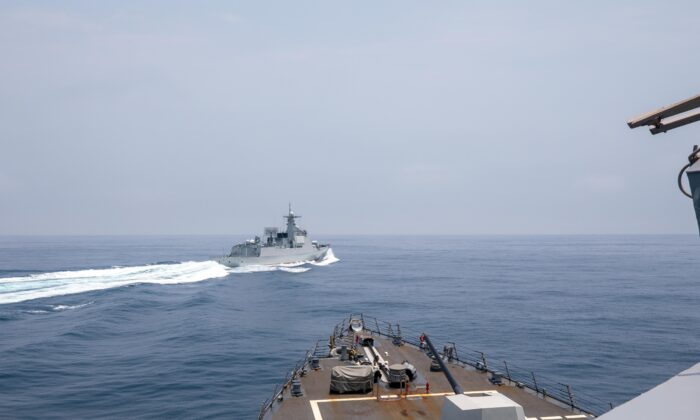Commentary
Involving over 125 aircraft and 34 coast guard and naval units, Beijing’s recent military drills around Taiwan give us some insights into Xi Jinping’s plans for forcing the island’s reunification with the People’s Republic of China (PRC).
This latest intimidation operation was intended to warn Taipei and its potential supporters that Beijing has the capability and will to isolate the democratically governed island from any external support or assistance. However, it also signaled that Xi intends to present the initial phase of a violent reunification effort as one justified under international law.
For example, the People’s Armed Police Coast Guard’s (PAPCG’s) opening participation indicates China may launch that gambit by declaring a maritime exclusion or quarantine zone around Taiwan. Coast Guard cutters not only circumnavigated the main island of Taiwan, they also patrolled in the waters off Taiwan’s islands just off China’s shores. Nor was this the first time the People’s Liberation Army (PLA) Eastern Theater Command has incorporated PAPCG and Maritime Security Agency (MSA) patrol craft in its exercises opposite Taiwan three times since 2022.
Seven PAPCG cutters participated in this latest exercise, and a similar number were active in last summer’s as well. Additionally, last August, the MSA’s largest patrol ship, the Type 918 Hai Xun 06, challenged a Taiwan ferry going the offshore island of Matsu. It did not board the ferry but demanded that it declare its cargo and destination and then escorted it outside Taiwan’s declared territorial waters. The patrol ship presented an intimidating presence for the ferry’s crew and passengers. The growing participation of PRC maritime law enforcement units is significant.
In effect, Beijing is at least considering a maritime law enforcement operation to isolate Taiwan from external support. It will not declare a blockade since that is an act of war typically employed against a hostile sovereign state, a status Beijing denies Taipei. Instead, Beijing argues that Taiwan is a renegade province, making all of its islands, air space, and waters sovereign PRC territory in “rebel” hands. Beijing claims that Taiwan’s status gives China the right under international law, including the United Nations Convention on the Law of the Sea (UNCLOS), to control access to that territory and regulate commerce and resources within Taipei’s economic exclusion zone.
Under that mindset, Beijing can argue that any maritime quarantine it declares against Taiwan constitutes a reasonable domestic law enforcement operation authorized under international law. It can use that declaration to monitor, intercept, and search shipping entering the quarantine zone to ensure the cargos contain no contraband or materials that Beijing considers supportive of the rebellion. Xi may hope to depict any foreign attempt to assist Taipei under those circumstances as an act of war violating Beijing’s right to re-establish its authority over a province in rebellion. That may give some Western leaders pause since they may have influential “legal experts” who accept Beijing’s interpretation.
China’s PAPCG is the world’s largest coast guard, and the waters around Taiwan off-China’s shore islands will be reinforced by the PRC’s Maritime Safety Administration’s units. Additionally, as is often the case in the South China Sea, the PAPCG will enjoy the backing of the responsible PLA Theater Command. The PLA Navy and Air Force will maintain patrols, presence, and readiness to respond to any challenges beyond the PAPCG’s capabilities. Equally important, recent missile tests by the PLA Rocket Force and past participation in Eastern Theater Command Exercises indicate preparations for potential anti-Taiwan operations if required.
The 13-hour-long Joint Sword-2024B was neither as large nor as complex as China’s earlier intimidation exercises against Taiwan. Still, it does demonstrate Beijing’s aggressive intentions and provides some potential insights into how it intends to achieve them. The PRC employs a more adroitly crafted narrative and operates with greater care and subtlety than America’s traditional enemies. It will present its acts as legitimate and lawful actions necessary to ending a rebellion on its territory. All of its military operations have a political narrative and purpose behind them.
Beijing’s “Three Warfares” doctrine integrates media, public opinion, and legal activities to shape the legal and political environment in its favor. The PRC often presents a positive legal façade to divide its opposition and hide its true intentions. Exposing what’s behind the façade is critical to deterring Xi’s aggressive plans. That may be the greatest challenge the United States and its allies face in deterring Xi’s destabilizing designs in the Western Pacific.
Views expressed in this article are opinions of the author and do not necessarily reflect the views of The Epoch Times.
Please rewrite this sentence.
Source link






